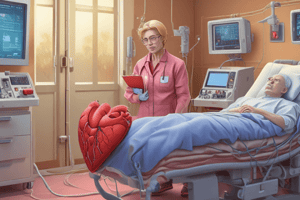Podcast
Questions and Answers
What is the primary purpose of providing general anaesthesia with endotracheal tube (ETT) during cardiac surgeries?
What is the primary purpose of providing general anaesthesia with endotracheal tube (ETT) during cardiac surgeries?
- To prevent excessive bleeding during surgery
- To ensure the patient remains unconscious during the procedure (correct)
- To eliminate the risk of infection
- To facilitate rapid recovery from anesthesia
Which factors are critical during the period of anaesthesia induction?
Which factors are critical during the period of anaesthesia induction?
- Administering local anaesthesia to minimize discomfort
- Confirming the patient's medical history
- Providing postoperative care to the patient
- Presence of the entire surgical team and monitoring for ventricular ischemia (correct)
What is the standard patient positioning for cardiac surgeries requiring a median sternotomy?
What is the standard patient positioning for cardiac surgeries requiring a median sternotomy?
- Prone position
- Lateral position
- Supine position (correct)
- Sitting position
Which suture is commonly used for anastomosis in vascular repairs during cardiac procedures?
Which suture is commonly used for anastomosis in vascular repairs during cardiac procedures?
What is a major count in cardiac surgeries?
What is a major count in cardiac surgeries?
What is the role of cardiopulmonary bypass (CPB) during cardiac surgery?
What is the role of cardiopulmonary bypass (CPB) during cardiac surgery?
Why is it essential to have orders and availability of blood products confirmed before cardiac surgery?
Why is it essential to have orders and availability of blood products confirmed before cardiac surgery?
Which of the following instruments is NOT considered a common cardiac surgical instrument?
Which of the following instruments is NOT considered a common cardiac surgical instrument?
What is the primary goal during cardiovascular emergency aneurysm repair?
What is the primary goal during cardiovascular emergency aneurysm repair?
Which of the following materials is NOT typically used for securing stents in an endograft procedure?
Which of the following materials is NOT typically used for securing stents in an endograft procedure?
What must the circulating and scrub nurses confirm before implantation of a prosthetic graft?
What must the circulating and scrub nurses confirm before implantation of a prosthetic graft?
In a femoral-popliteal bypass in situ, what happens to the saphenous vein?
In a femoral-popliteal bypass in situ, what happens to the saphenous vein?
What equipment is essential on the sterile table for a cardiovascular aneurysm repair procedure?
What equipment is essential on the sterile table for a cardiovascular aneurysm repair procedure?
Which method of grafting does NOT involve removing the saphenous vein from its natural location?
Which method of grafting does NOT involve removing the saphenous vein from its natural location?
What is a crucial step when preparing for a risk of converting to an open procedure?
What is a crucial step when preparing for a risk of converting to an open procedure?
In permanent pacemaker insertion, what is the method of introduction for the leads?
In permanent pacemaker insertion, what is the method of introduction for the leads?
What is the primary advantage of using the Left Internal Mammary Artery (LIMA) as a graft over a saphenous vein?
What is the primary advantage of using the Left Internal Mammary Artery (LIMA) as a graft over a saphenous vein?
Which of the following procedural considerations is not associated with valve repair or replacement?
Which of the following procedural considerations is not associated with valve repair or replacement?
When preparing for a valve replacement, what must the perioperative nurse confirm?
When preparing for a valve replacement, what must the perioperative nurse confirm?
What complication is associated with valve regurgitation?
What complication is associated with valve regurgitation?
Which of the following is a method of arterial grafting mentioned?
Which of the following is a method of arterial grafting mentioned?
What type of valve requires a patient to be placed on long-term anticoagulation therapy?
What type of valve requires a patient to be placed on long-term anticoagulation therapy?
Which procedural step is essential before closing the sternum after a bypass procedure?
Which procedural step is essential before closing the sternum after a bypass procedure?
What condition necessitates valve repair or replacement in cardiovascular surgery?
What condition necessitates valve repair or replacement in cardiovascular surgery?
What is the main purpose of the pulse generator in bradydysrhythmias?
What is the main purpose of the pulse generator in bradydysrhythmias?
Which procedural step is emphasized for both pulse generator and ICD insertions?
Which procedural step is emphasized for both pulse generator and ICD insertions?
What typically occurs in the operating room during an ICD insertion procedure?
What typically occurs in the operating room during an ICD insertion procedure?
What must be confirmed prior to implanting an ICD?
What must be confirmed prior to implanting an ICD?
Which of the following is a similarity between ICDs and permanent pacemakers?
Which of the following is a similarity between ICDs and permanent pacemakers?
What safety measure is taken during the testing of an ICD in the operating room?
What safety measure is taken during the testing of an ICD in the operating room?
What is not typically a part of the ICD insertion procedure?
What is not typically a part of the ICD insertion procedure?
During the insertion of a pulse generator, what is the expected duration of the procedure?
During the insertion of a pulse generator, what is the expected duration of the procedure?
What characteristic distinguishes arteries from veins?
What characteristic distinguishes arteries from veins?
Which of the following statements about veins is correct?
Which of the following statements about veins is correct?
What is the primary purpose of heparinized saline in vascular surgery?
What is the primary purpose of heparinized saline in vascular surgery?
Which statement about the tunica media is correct?
Which statement about the tunica media is correct?
What type of disease may lead to a diagnosis of acute arterial insufficiency?
What type of disease may lead to a diagnosis of acute arterial insufficiency?
Which medication is used as a vasodilator in vascular surgery?
Which medication is used as a vasodilator in vascular surgery?
What is a common symptom displayed by patients with vascular disease?
What is a common symptom displayed by patients with vascular disease?
What is the role of absorbable gelatin sponge in vascular surgery?
What is the role of absorbable gelatin sponge in vascular surgery?
Flashcards are hidden until you start studying
Study Notes
Anaesthesia Considerations
- General anaesthesia with endotracheal tube (ETT) required for ACB or valve surgeries.
- Induction phase is critical for monitoring, especially in patients with ventricular ischemia.
- Presence of the entire surgical team is essential during anaesthesia induction.
- Blood replacement may be necessary due to extensive tissue dissection; confirm blood product availability at all stages.
Patient Positioning and Surgical Preparation
- Median sternotomy is performed for valve replacement or ACB procedures.
- Patients are positioned supine to optimize surgical exposure.
- Reference the ORNAC Standards and positioning checklist for best practices.
Common Cardiac Instruments
- Key instruments include Potts scissors, Castroviejo needle holders, Ryder needle holders, and various clamps.
- Saphenous vein grafts are often used in ACBs, which can be harvested using minimally invasive techniques.
- Endoscopic instruments such as camera and endoscopic scissors are employed for certain procedures.
Cardiopulmonary Bypass (CPB)
- CPB acts as a temporary substitute for the heart and lungs by diverting blood flow during surgery.
- This technique allows for a still and bloodless surgical field.
Grafting Techniques
- LIMA (Left Internal Mammary Artery) and RIMA (Right Internal Mammary Artery) are preferred for grafting due to their durability compared to saphenous veins.
- Saphenous veins are less durable and under lower pressure than arteries.
Valve Repair/Replacement
- Indications for procedure include stenosis and regurgitation.
- The type of valve (mechanical or bioprosthesis) impacts postoperative care, particularly regarding anticoagulation therapy.
Structure of Vascular System
- Arteries: thicker walls, more elastic, capable of contraction; carry blood away from the heart.
- Veins: thinner walls, contain valves to prevent backflow; carry blood toward the heart.
Vascular Disease and Surgical Considerations
- Patients may have aortic aneurysms or chronic arterial insufficiency.
- Topical hemostatic agents and medications (e.g., heparinized saline, papavarine) play critical roles in surgery.
Emergency Aneurysm Repair
- Immediate clamping of a ruptured aneurysm is crucial; counts might be skipped in urgent situations.
- Key instruments and supplies must be prepared and readily available.
Femoral Popliteal Bypass
- Can be performed using the patient’s own vein or a prosthetic graft to restore leg blood flow.
- In situ procedures involve using the saphenous vein without removal, necessitating the removal of valves.
Pacemaker Insertion
- Electrodes are placed through the subclavian vein to facilitate heart chamber connection; pulse generators are implanted subcutaneously.
- Strict aseptic technique must be followed to prevent infection.
Implantable Cardioverter Defibrillator (ICD) Insertion
- ICDs monitor electrical activity and deliver shocks for ventricular tachycardia or fibrillation.
- Similar protocols to pacemaker insertion, but with additional capability for pacing and defibrillation; require strict aseptic technique.
Key Procedural Considerations
- Documentation of implant type and patient details is essential for all surgical procedures.
- Continuous monitoring and preparation by surgical staff are crucial throughout cardiovascular surgeries.
Studying That Suits You
Use AI to generate personalized quizzes and flashcards to suit your learning preferences.




